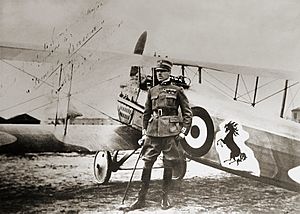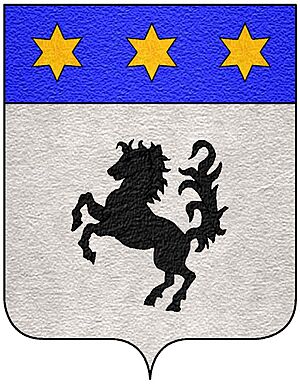Francesco Baracca facts for kids
Quick facts for kids
Count Francesco Baracca
|
|
|---|---|

|
|
| Born | 9 May 1888 Lugo di Romagna, Emilia-Romagna, Kingdom of Italy |
| Died | 19 June 1918 (aged 30) near Monte Montello, Italy |
| Allegiance | Italy |
| Service/ |
Italian Army Corpo Aeronautico Militare |
| Years of service | 1907 – 1918 |
| Rank | Major |
| Unit | 1a Squadriglia, 70a Squadriglia, 91a Squadriglia |
| Awards | Gold Medal of Military Valor, three Silver Medal of Military Valor, British Military Cross, French Croix de Guerre, Belgian Order of the Crown |

Francesco Baracca (born May 9, 1888 – died June 19, 1918) was Italy's best fighter pilot during World War I. He was known for shooting down 34 enemy airplanes. His personal symbol, a black horse standing on its back legs, later inspired Enzo Ferrari to use it as the famous logo for his Ferrari cars.
Contents
Early Life and Flying Dreams
Francesco Baracca was born in Lugo, Italy. His father, Enrico Baracca, was a wealthy landowner. Francesco first went to a private school in Florence. In October 1907, he joined the Military Academy of Modena.
He loved horses and became a cavalryman in a famous regiment called Piemonte Reale Cavalleria in 1910. He enjoyed horse riding and hunting. Later, Francesco became interested in flying. He learned to fly in Reims, France, and got his pilot's license in July 1912.
Flying in World War I
When World War I started, Italy joined the Allied side in May 1915. Baracca was sent to Paris to learn to fly Nieuport two-seater planes. In July, he joined the 8a Squadriglia Nieuport.
His first planes, the Nieuport 10s, were not very good against enemy attacks. They were too slow and couldn't climb fast enough to fight. Pilots even flew without observers to make the planes lighter, but it didn't help much.
First Victory and the Prancing Horse
In April 1916, Baracca started flying the new Nieuport 11 fighter plane. On April 7, he scored his first victory. He shot holes in the fuel tank of an Austrian Hansa-Brandenburg C.I plane. This was Italy's very first aerial victory in the war!
His favorite way to attack was to zoom in quietly from behind and below an enemy plane. He would then fire his machine gun from very close range.
Around this time, Baracca chose a special symbol for his plane: a black horse standing on its back legs. This was a tribute to his old cavalry regiment. Because of this, some people called him "The Cavalier of the Skies."
He continued to fly different planes, like the Nieuport 17 and later the SPAD VII. He achieved many victories, sometimes alone and sometimes with other Italian aces.
Becoming a Famous Ace
Baracca's second victory was an Austrian Lohner plane over Gorizia in April 1916. After his third victory, he moved to the 70a Squadriglia. He was promoted to Capitano (Captain).
With nine victories, he moved to the new 91st Squadriglia in May 1917. This squadron was known as the "Squadron of the Aces." By then, he was very famous across Italy for his growing list of victories. He became the leader of this squadron.
One time, his friend Fulco Ruffo di Calabria almost accidentally shot him down. Ruffo di Calabria fired at an enemy plane but nearly hit Baracca instead. Later, Baracca joked, "Dear Fulco, next time, if you want to shoot me down, aim a couple of meters to the right."
In October 1917, Baracca tried a new plane, the Spad XIII. He used it for a few victories. However, his plane was damaged in a dogfight. He preferred the more agile Spad VII, saying, "It doesn't matter if the VII is equipped with a single gun. Provided you are a good fighter, a single gun is just enough."
A Modest and Caring Pilot
Baracca was a dedicated fighter pilot. He didn't like being away from the front lines. He stayed with the 91st Squadriglia as much as possible, even after being promoted to Maggiore (Major) in November 1917.
He was known for being modest and kind. He cared about his fellow pilots and even his defeated enemies. He would try to visit his victims in the hospital or place a wreath on the graves of those he killed. By the end of 1917, he had 30 victories.
In March 1918, Baracca returned to the front. He adopted a new symbol for his unit's planes: a griffin. Most of his pilots used this new symbol, but some still kept the prancing horse to show respect for their commander.
Final Mission and Legacy
Baracca didn't see much action in 1918, but he added more victories, reaching a total of 34. On June 19, he went on a mission to attack ground targets in the Montello (hill) area. He never returned.
During this mission, Italian planes were flying very low to support troops, facing heavy ground fire. Baracca and a new pilot, Franco Osnago, were hit by ground fire and separated. Soon after, a burning plane was seen falling.
A few days later, on June 24, Baracca's body was found near the burnt remains of his Spad VII. A monument was later built at that spot to honor him.

When his body was found, it looked like he had been shot in the head. His pistol was out of its holster, leading some to wonder if he took his own life rather than crash or be captured. However, the most accepted idea is that he was hit by ground fire. Records from the Austro-Hungarian side suggest he was killed by a gunner from an Austrian two-seater plane while attacking.
Lasting Impact
Francesco Baracca's 34 victories make him one of the highest-scoring Allied pilots of World War I. After the war, his home in Lugo di Romagna became the Francesco Baracca Museum. It displays his belongings, uniforms, and medals.
Many roads and airports in Italy are named after him. A large monument to his memory stands in the main square of his hometown.
Years later, Baracca's mother gave his famous prancing horse emblem, the Cavallino Rampante, to Enzo Ferrari. This prancing horse has been the official symbol of the Scuderia Ferrari racing team since 1929. It is also the symbol of all Ferrari cars. The "Flying Aces" roller coaster at Ferrari World on Yas Island is named after him and designed with his story in mind.
He received many awards for his bravery, including the Gold Medal of Military Valor.
See also
- Luigi Olivari
- Giovanni Sabelli
- Flavio Baracchini
- Guido Nardini
- Giorgio Pessi
- Attilio Imolesi
- Gastone Novelli
- Pier Ruggero Piccio
- Fulco Ruffo di Calabria


